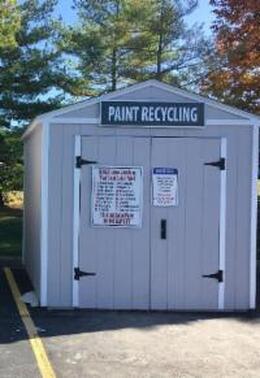|
When paint is not stored or disposed of properly, paint can become a hazardous waste! To avoid health and environmental hazards, using, storing and disposing of paint should be done correctly. Understanding Paint Components: According to University of Missouri Extension, most paint has four components: resin, solvent, pigment and additives. To determine the hazardous ingredients of paint, request a Material Safety Data Sheet from the retailer when you buy it. The resin is the main ingredient and forms a coating or film on the surface being painted. This typically non-hazardous component includes linseed, acrylic or other synthetic resins. The solvent keeps the paint in a liquid form until the solvent evaporates after the paint is applied. The solvent in oil-based paint is derived from a petroleum distillate and can include such hazardous ingredients as mineral spirits, toluene and xylene. The solvent in latex paint is water. Pigments provide the color and opacity or covering power. The major pigments used presently are titanium oxide, iron oxide, calcium sulfate, clay or silicates. These pigments are relatively nontoxic. Some highly colored pigments may contain heavy metals such as chromium, cadmium or arsenic. Paints purchased before 1977 may contain lead in the pigment. Lead, also a heavy metal, is poisonous. Do not use paint purchased prior to 1977. To determine if the painted surfaces in your home contain lead, contact your local health department or a lead paint removal contractor. Paint may also have additives. Some types of additives include stabilizers that prevent paint deterioration in the can, dryers that assist in the formation of the paint coating, thickeners that aid in application, and preservatives that inhibit the growth of molds. The additives can range in composition, including both hazardous and non-hazardous ingredients. Some latex paints contain a mercury-based fungicide preservative. Mercury is a heavy metal that is highly toxic. Paints containing mercury produced since August 1990 had to be labeled exclusively for exterior use. Proper Paint Storage:
For questions regarding Warren County Soil and Water Conservation District programs and/or technical assistance on water or soil questions, visit http://warrenswcd.com or call, 513-695-1337.
1 Comment
9/27/2023 07:18:09 am
Hello, Thanks for the sharing this blog. this blog is very helpfull for me . if you want any help regarding awagami kitakata select paper then contact with Kings Framing & Art Gallery .
Reply
Leave a Reply. |
Details
Warren County SWCD Staff BlogA blog to keep you informed on all the latest news at Warren County SWCD and in the conservation world. Archives
May 2024
Categories
All
|
|
|
Contact:PHONE: (513) 695 - 1337
EMAIL: [email protected] HOURS: Monday - Friday 7:30am - 4:00pm (except holidays) Connect:Warren County Soil & Water Conservation District Copyright © 2016
Warren SWCD Privacy Notice. Emails are serviced by Constant Contact. Constant Contact's Privacy Notice. |


